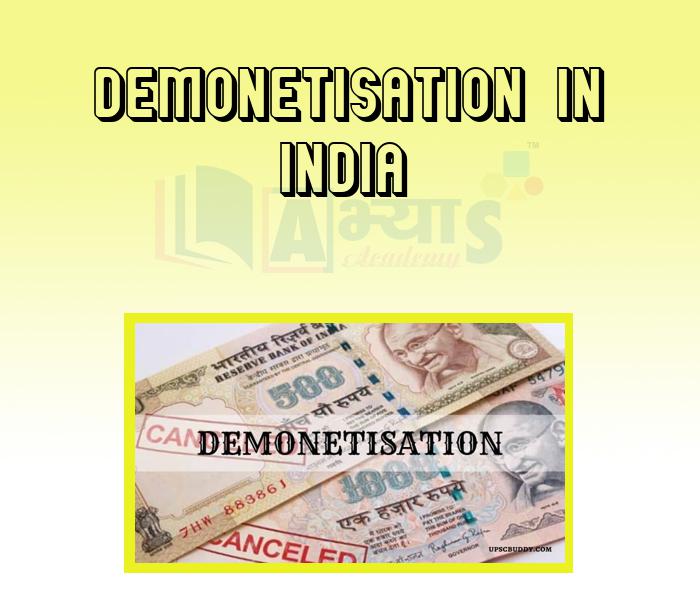Demonetisation in India









Demonetisation in India
Demonetisation in India"Demonetisation is the withdrawal of a particular form of currency from circulation." Through demonetisation, the old currency is replaced by the new currency or a currency circulation is blocked. There are multiple reasons why a country demonetises its currency. Some reasons include - checking the inflation, curbing the corruption and promoting the cashless transactions.Recently, the Indian government decided to demonetise the highest denomination notes i.e. 500 and 1,000 Rupees notes. This step has been declared as a master stroke for the Indian economy by various experts. This is not the first time that India has demonetised its currency. Earlier, it was done in 1946 with the complete ban of Rs. 1,000 and Rs, 10,000 notes to deal with the unaccounted money i.e. black money. Second time, it was done in 1978 by the Government headed by Morarji Desai, when Rs. 1000, Rs. 5000 and Rs. 10,000 notes were demonetised. Indian Government's goal was to remove all counterfeit (fake) currency from the market which is used in tax evasion corruption and even in funding terrorist activities. This step is considered as cleanliness drive against the black money in the history of Indian economy. AS per RBI, 87% transactions in India are cash transactions and this loophole is used by corrupt people to build a parallel economy with unaccounted money. This parallel economy helps in terror financing, which in turn hampers the growth and development of country. High- values notes (Rs. 500 and Rs 1000) accounted for total value of 86% of the notes in circulation in India.
Notes in circulation as on November 4, 2016: Rs. 17,742 billion (13% of GDP)
Value of Rs. go0/1000 notes in circulation (86.5% of notes in circulation): Rs. 15,347 billion (11% of GDP)It is expected that this step will help in reducing the fiscal deficit of India and will promote the cashless economy in India that can be easily monitored. While currency notes of Rs. 500 were re-issued, Rs 1,000 currency notes were completely done away with. Additionally, the technologically advancednotes of denomination 5o0 and 2,000 were introduced.Impact of DemonetisationAlthough people with black money obviously stand the most affected, there are several implications that have to be faced by the average middle class person, farmers, banks and the economy as a whole.1. Impact on Economy:The Reserve Bank, in its fifth Bi-monthly Monetary Policy Statement on December 7, 2016, placed the GVA (Gross Value Added) growth for 2016-17 at 7.1 per cent, which was lower than 7.6 per cent GVA growth projected in its fourth Bi-monthly Monetary Policy Statement of October 4, 2016.2. Impact on farmers:Farmers beard the hardest burnt of the demonetisation:(i) Farmers were unable to purchase inputs Eke certified HYV seeds from market. They were using old seeds from the last year harvest and not purchasing quality seeds from market. This will adversely affect crop yields despite good monsoon this year.(ii) Farmers suffered a setback due to nationwide cash crunch and a collapse in the demand vegetables in wholesale markets. It also affected the retail vegetable sellers, as they kept inventories of perishable commodities.
3. Surge in cashless transactions:(i) Transactions on e-wallets have increased from Rs. 17 lakh per day to Rs. 63 lakh per day and value of the transactions has increased from Rs. 52 crore to Rs. 191 crore.(ii) Volume of transactions using Rupay Card has increased from Rs. 3.85 lakh per day to 16 per day and value the transactions has increased from Rs. 39.17 crore to Rs. 236 crore.
Students / Parents Reviews [10]
One of the best institutes to develope a child interest in studies.Provides SST and English knowledge also unlike other institutes. Teachers are co operative and friendly online tests andPPT develope practical knowledge also.

Aman Kumar Shrivastava
10thMy experience with Abhyas is very good. I have learnt many things here like vedic maths and reasoning also. Teachers here first take our doubts and then there are assignments to verify our weak points.

Shivam Rana
7thIt has a great methodology. Students here can get analysis to their test quickly.We can learn easily through PPTs and the testing methods are good. We know that where we have to practice

Barkha Arora
10thIt was good as the experience because as we had come here we had been improved in a such envirnment created here.Extra is taught which is beneficial for future.

Eshan Arora
8thAbout Abhyas metholodology the teachers are very nice and hardworking toward students.The Centre Head Mrs Anu Sethi is also a brilliant teacher.Abhyas has taught me how to overcome problems and has always taken my doubts and suppoeted me.

Shreya Shrivastava
8thI have spent a wonderful time in Abhyas academy. It has made my reasoning more apt, English more stronger and Maths an interesting subject for me. It has given me a habbit of self studying

Yatharthi Sharma
10thAbhyas Methodology is very good. It is based on according to student and each child manages accordingly to its properly. Methodology has improved the abilities of students to shine them in future.

Manish Kumar
10thA marvelous experience with Abhyas. I am glad to share that my ward has achieved more than enough at the Ambala ABHYAS centre. Years have passed on and more and more he has gained. May the centre flourish and develop day by day by the grace of God.

Archit Segal
7thAbhyas is a complete education Institute. Here extreme care is taken by teacher with the help of regular exam. Extra classes also conducted by the institute, if the student is weak.

Om Umang
10thMy experience was very good with Abhyas academy. I am studying here from 6th class and I am satisfied by its results in my life. I improved a lot here ahead of school syllabus.
